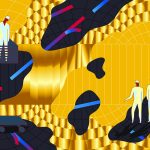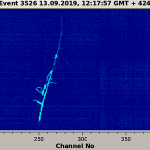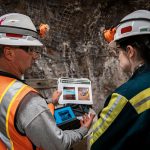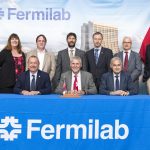Advances in subatomic physics heavily depend on ingenuity and technology. And when it comes to discovering the nature of some of the most elusive particles in the universe, neutrinos, scientists need the best and most sensitive detector technology possible. Scientists working at CERN have started tests of a new neutrino detector prototype, using a very promising technology called “dual phase.”
Deep Underground Neutrino Experiment
From Rapid City Journal, Oct. 9, 2019: For the past 17 years, shovels, safety goggles, tramway cars and other remains of the defunct Homestake gold mine lingered in a closed-off tunnel under the city of Lead, South Dakota. Now the tunnel is alive with activity again, thanks to preparations for the Long-Baseline Neutrino Facility and the international Deep Underground Neutrino Experiment, hosted by Fermilab.
From CERN, Oct. 9, 2019: Scientists working at CERN have started tests of a prototype for a new neutrino detector, using novel and very promising technology called “dual phase.” If successful, this technology will be used at a much larger scale for the international Deep Underground Neutrino Experiment, hosted at Fermilab in the U.S.
From CNRS, Oct. 10, 2019: Les scientifiques de la collaboration ProtoDUNE au CERN ont commencé à tester un tout nouveau prototype de détecteur de neutrinos, en utilisant une technologie très prometteuse, appelée “double phase.” Si les premiers résultats obtenus se confirment, cette nouvelle technologie sera utilisée à une plus grande échelle pour l’expérience internationale DUNE aux États-Unis. Les scientifiques français du CNRS et du CEA jouent un rôle de premier plan dans le développement et la mise en route de ce détecteur innovant.
From Rapid City Journal, Oct. 10, 2019: Fermilab Director Nigel Lockyer comments on British contributions to the Deep Underground Neutrino Experiment during an Oct. 8 event in which British air power and science were feted Tuesday in Rapid City, South Dakota. Honored guests included the Royal Air Force’s Red Arrows Aerobatic Team, a British diplomat and a group of U.S. and international scientists associated with the Deep Underground Neutrino Experiment.
Scientists working at CERN have started tests of a new neutrino detector prototype using a promising technology called “dual phase.” If successful, this new technology will be used at a much larger scale for the international Deep Underground Neutrino Experiment, hosted by Fermilab. Scientists began operating the dual-phase prototype detector at CERN at the end of August and have observed first tracks. The new technology may be game-changing, as it would significantly amplify the faint signals that particles create when moving through the detector.
From Sanford Underground Research Facility, Sept. 27, 2019: Several projects are under way at Sanford Underground Research Facility to improve the reliability of the facility’s infrastructure. Crews are improving the facility for its role as the far site for Fermilab’s Long-Baseline Neutrino Facility. The LBNF project recently completed an upgrade of the main ventilation fan for the underground facility.
From pieuvre.ca, Sept. 24, 2019: Une équipe de chercheurs dirigés par Christopher Mauger, dans une étude récemment publiée, avance certaines options pouvant faire en partie la lumière sur cet étrange phénomène et répondre à d’autres questions dans le domaine de la physique fondamentale. Dans le cadre du programme CAPTAIN représentent une première étape importante pour la mise sur pied du DUNE, une installation expérimentale pour l’étude des neutrinos et de la physique des particules.




